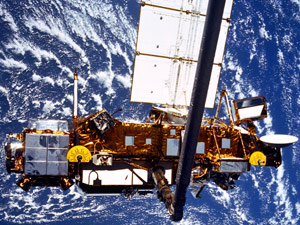 A NASA satellite has plunged to earth, breaking up and possibly scattering debris in Canada, NASA said.
A NASA satellite has plunged to earth, breaking up and possibly scattering debris in Canada, NASA said.
There were reports on Twitter of debris falling over Okotoks, a town south of Calgary in western Canada, most likely the remains of the Upper Atmosphere Research Satellite, or UARS, which had been in orbit for 20 years.
The satellite weighs 5,897kg and is about the size of a bus.
Scientists were unable to pinpoint the exact time and place where UARS would return to Earth due to the satellite’s unpredictable tumbles as it plowed through the upper atmosphere.
With most of the planet covered in water and vast uninhabited deserts and other land directly beneath the satellite’s flight path, the chance that someone would be hit by falling debris is 1-in-3,200, NASA said.
Stretching 10.6 metres long and 14.5 metres in diameter, UARS is among the largest spacecraft to plummet uncontrollably through the atmosphere. Although it is a slim cousin to NASA’s 75-ton Skylab station, which crashed to Earth in 1979.
Russia’s last space station, the 135-ton Mir, crashed into the Pacific Ocean in 2001, but it was a guided descent.
NASA now plans for the controlled re-entry of large spacecraft, but it did not when UARS was designed.
The satellite was dispatched into orbit by a space shuttle crew in 1991 to study ozone and other chemicals in Earth’s atmosphere. It completed its mission in 2005 and has been slowly losing altitude ever since, pulled by the planet’s gravity.
Most of the spacecraft will burn up during the fiery plunge through the atmosphere, but about 26 individual pieces, weighing a total of about 500 kg were expected to survive the incineration and land somewhere on Earth.
The satellite was one of about 20,000 pieces of space debris loitering in orbit around Earth. Something the size of UARS falls back into the atmosphere about once a year.
Leave a Reply
You must be logged in to post a comment.